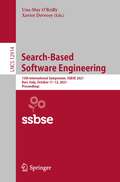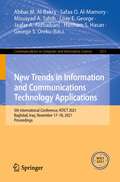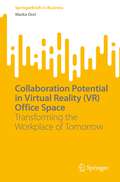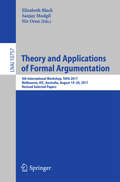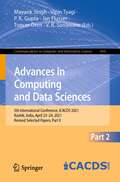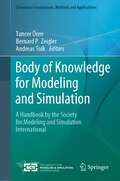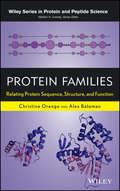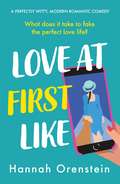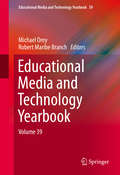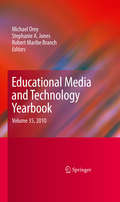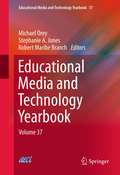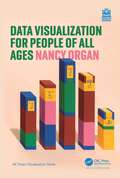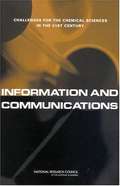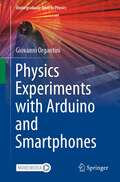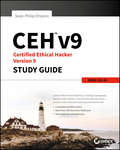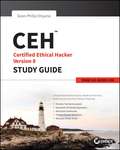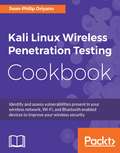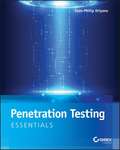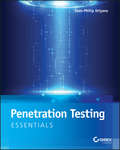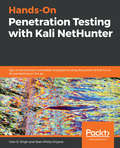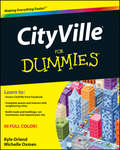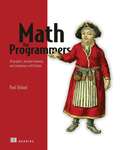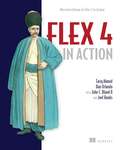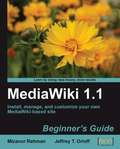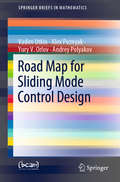- Table View
- List View
Search-Based Software Engineering: 13th International Symposium, SSBSE 2021, Bari, Italy, October 11–12, 2021, Proceedings (Lecture Notes in Computer Science #12914)
by Una-May O’Reilly Xavier DevroeyThis book constitutes the proceedings of the 13th International Symposium on Search-Based Software Engineering, SSBSE 2021, which was held in Bari, Italy, during October 11-12, 2021. The 9 full and 2 short papers included in this volume were carefully reviewed and selected from 19 submissions. The papers deal with novel ideas and applications of search-based software engineering, focusing on engineering challenges and the application of automated approaches and optimization techniques from AI and machine learning research.
New Trends in Information and Communications Technology Applications: 5th International Conference, NTICT 2021, Baghdad, Iraq, November 17–18, 2021, Proceedings (Communications in Computer and Information Science #1511)
by George S. Oreku Abbas M. Al-Bakry Safaa O. Al-Mamory Mouayad A. Sahib Haitham S. Hasan Loay E. George Jaafar A. AldhaibaniThis book constitutes refereed proceedings of the 5th International Conference on New Trends in Information and Communications Technology Applications, NTICT 2021, held in Baghdad, Iraq, in November 2021. The 13 full papers presented were thoroughly reviewed and selected from 52 qualified submissions. The volume presents the latest research results in such areas as network protocols, overlay and other logical network structures, wireless access networks, computer vision, machine learning, artificial Intelligence, data mining, control methods.
Collaboration Potential in Virtual Reality: Transforming the Workplace of Tomorrow (SpringerBriefs in Business)
by Marko OrelThe recent shift in labour markets has heightened the demand for alternative work arrangements. Virtual reality (VR) technology plays a significant role in this transition, with remote work as efficient as work performed from an organization's own office space. This book explores the impact of immersive VR technology on the new virtual workspace. Specifically, it examines how VR can enable employees to overcome the distractions associated with working from home, increase their visibility on team projects, build stronger relationships with co-workers, reduce feelings of isolation due to social distancing, and facilitate their engagement in collaborative work processes. It also explores the limitations of two-dimensional, computer-mediated communication tools for flexible working arrangements. It, thus, offers theoretical foundations for future research on office digitalization and subsequent applications of VR technology on office work. It also features the analysis of two dozen problem-centered expert interviews with creators and executives of leading productivity VR tools that enable the remote collaboration between knowledge workers.
Theory and Applications of Formal Argumentation: Second International Workshop, Tafa 2013, Beijing, China, August 3-5, 2013, Revised Selected Papers (Lecture Notes in Computer Science #8306)
by Nir Oren Sanjay Modgil Elizabeth BlackThis book constitutes the refereed proceedings of the 4th International Workshop on the Theory and Applications of Formal Argumentation, TAFA 2017, held in Melbourne, VIC, Australia, in August 2017. The workshop was co-located with International Joint Conference on Artifi cial Intelligence(IJCAI 2017). The 15 revised full papers presented were carefully reviewed and selected from 20 submissions. The workshops covers the subjects such as non-monotonic reasoning, decision making, inter-agent communication, the semantic web, grid applications, ontologies, recommender systems, machine learning, neural networks, trust computing, normative systems, social choice theory, judgement aggregation and game theory, and law and medicine.
Advances in Computing and Data Sciences: 5th International Conference, ICACDS 2021, Nashik, India, April 23–24, 2021, Revised Selected Papers, Part II (Communications in Computer and Information Science #1441)
by Tuncer Ören Jan Flusser Mayank Singh P. K. Gupta Vipin Tyagi V. R. SonawaneThis two-volume book constitutes the post-conference proceedings of the 5th International Conference on Advances in Computing and Data Sciences, ICACDS 2021, held in Nashik, India, in April 2021.*The 103 full papers were carefully reviewed and selected from 781 submissions. Part II is devoted to data sciences, organizing principles, medical technologies, computational linguistics etc.*The conference was held virtually due to the COVID-19 pandemic.
Body of Knowledge for Modeling and Simulation: A Handbook by the Society for Modeling and Simulation International (Simulation Foundations, Methods and Applications)
by Tuncer Ören Bernard P. Zeigler Andreas TolkCommissioned by the Society for Modeling and Simulation International (SCS), this needed, useful new ‘Body of Knowledge’ (BoK) collects and organizes the common understanding of a wide collection of professionals and professional associations.Modeling and simulation (M&S) is a ubiquitous discipline that lays the computational foundation for real and virtual experimentation, clearly stating boundaries—and interactions—of systems, data, and representations. The field is well known, too, for its training support via simulations and simulators. Indeed, with computers increasingly influencing the activities of today’s world, M&S is the third pillar of scientific understanding, taking its place along with theory building and empirical observation.This valuable new handbook provides intellectual support for all disciplines in analysis, design and optimization. It contributes increasingly to the growing number of computational disciplines, addressing the broad variety of contributing as well as supported disciplines and application domains. Further, each of its sections provide numerous references for further information. Highly comprehensive, the BoK represents many viewpoints and facets, captured under such topics as:Mathematical and Systems Theory FoundationsSimulation Formalisms and ParadigmsSynergies with Systems Engineering and Artificial IntelligenceMultidisciplinary ChallengesEthics and PhilosophyHistorical PerspectivesExamining theoretical as well as practical challenges, this unique volume addresses the many facets of M&S for scholars, students, and practitioners. As such, it affords readers from all science, engineering, and arts disciplines a comprehensive and concise representation of concepts, terms, and activities needed to explain the M&S discipline.Tuncer Ören is Professor Emeritus at the University of Ottawa. Bernard Zeigler is Professor Emeritus at the University of Arizona. Andreas Tolk is Chief Scientist at The MITRE Corporation. All three editors are long-time members and Fellows of the Society for Modeling and Simulation International. Under the leadership of three SCS Fellows, Dr. Ören, University of Ottawa, Dr. Zeigler, The University of Arizona, and Dr. Tolk, The MITRE Corporation, more than 50 international scholars from 15 countries provided insights and experience to compile this initial M&S Body of Knowledge.
Protein Families
by Christine Orengo Vladimir Uversky Alex BatemanNew insights into the evolution and nature of proteinsExploring several distinct approaches, this book describes the methods for comparing protein sequences and protein structures in order to identify homologous relationships and classify proteins and protein domains into evolutionary families. Readers will discover the common features as well as the key philosophical differences underlying the major protein classification systems, including Pfam, Panther, SCOP, and CATH. Moreover, they'll discover how these systems can be used to understand the evolution of protein families as well as understand and predict the degree to which structural and functional information are shared between relatives in a protein family.Edited and authored by leading international experts, Protein Families offers new insights into protein families that are important to medical research as well as protein families that help us understand biological systems and key biological processes such as cell signaling and the immune response. The book is divided into three sections: Section I: Concepts Underlying Protein Family Classification reviews the major strategies for identifying homologous proteins and classifying them into families. Section II: In-Depth Reviews of Protein Families focuses on some fascinating super protein families for which we have substantial amounts of sequence, structural and functional data, making it possible to trace the emergence of functionally diverse relatives. Section III: Review of Protein Families in Important Biological Systems examines protein families associated with a particular biological theme, such as the cytoskeleton.All chapters are extensively illustrated, including depictions of evolutionary relationships. References at the end of each chapter guide readers to original research papers and reviews in the field.Covering protein family classification systems alongside detailed descriptions of select protein families, this book offers biochemists, molecular biologists, protein scientists, structural biologists, and bioinformaticians new insight into the evolution and nature of proteins.
Love at First Like: A wise and witty rom-com of love in the digital age
by Hannah OrensteinIf you love Jo Watson, Zara Stoneley and Sophie Ranald, you'll LOVE Hannah Orenstein!'A good read for the holidays (or lockdown)' 5* reader review*Includes a special preview of Head Over Heels, Hannah's glorious new rom-com that will make you CHEER!*Love at First Like is the perfect rom-com for anyone who's ever looked for love online!'Such a perfect book for this digital age' 5* reader review'The perfect vacation read!' 5* reader review'I inhaled this book' 5* reader reviewWHAT DOES IT TAKE TO FAKE THE PERFECT LOVE LIFE?Eliza Roth and her sister Sophie co-own a jewelry shop in Brooklyn. One night, after learning of an ex's engagement, Eliza accidentally posts a photo of herself wearing a diamond ring on that finger to her Instagram account beloved by 100,000 followers. Sales skyrocket, press rolls in, and Eliza learns that her personal life is good for business. So she has a choice: continue the ruse or clear up the misunderstanding. With mounting financial pressure, Eliza sets off to find a fake fiancé.Fellow entrepreneur Blake seems like the perfect match on paper, and in real life he shows promise too - if only Eliza didn't feel also drawn to someone else. But Blake doesn't know Eliza is 'engaged'; Sophie asks Eliza for an impossible sum of money; and Eliza's lies start to spiral out of control. Now she can either stay engaged online - or fall in love in real life.Written with singular charm and style, Love at First Like is for anyone growing up and settling down in the digital age.'This glittering gem of a novel is a wise and witty take on family, ambition, and modern love' Andrea Dunlop, author of We Came to Forget
Educational Media and Technology Yearbook, Volume 39
by Michael Orey Robert Maribe BranchThis book is an annual publication entering its 40th year. The series represents current trend and issues in the field of educational communications and technology, journals and other periodicals associated with the field, and the academic programs that prepare instructional technology professionals. Springer has been the publisher for the series, in cooperation with the Association for Educational Communications and Technology, for the past four years. Volume 39 will feature a section on Information Studies, in addition to updated information about programs and a new ranking of the top academic degree programs in the field of Learning, Design, and Technology.
Educational Media and Technology Yearbook, Volume 35
by Michael Orey Stephanie A. Jones Robert Maribe BranchThe evolution of educational technology has seen a shift from hardware and software to tactics and techniques, as the 2010 edition of the Educational Media and Technology Yearbook makes abundantly clear. As in previous years, it offers the reader a snapshot of the moment and a look ahead to issues most likely to shape the immediate future--an array as varied as the use of social networking sites in learning, new collaborations between media specialists and non-teaching school personnel, and the emerging discipline of Human Performance Technology. Here are ideas that are not only intellectually intriguing but also practical and practice-building, inspiring educators using computer technology to move beyond traditional teaching roles toward learning design. Included in the 2010 Yearbook: Salient issues in learning, design, and technology, such as the critical part school leadership plays in instructors' acceptance or rejection of technology, New trends in library and information science, including the role of school library media centers in preventing cyberbullying, This year's leadership profiles: Jerrold Kemp, author of Designing Effective Instruction; W. Michael Reed, accomplished, dedicated, and recognized educator in instructional technology, A worldwide directory of current professional associations and organizations in learning design, technology, information, and library science, Up-to-date listings of graduate program in these fields, rated using a variety of criteria, Special mediagraphy section featuring journals, ERIC documents, and media-related publications in specialized areas, including distance education, simulation/virtual reality, artificial intelligence, special education, and professional development. Academics in learning design and technology, and information and library science will welcome the latest edition of the Educational Media and Technology Yearbook as a reference, idea book, and a panoramic study of where we are now.
Educational Media and Technology Yearbook, Volume 37
by Michael Orey Stephanie A. Jones Robert Maribe Branch As digital devices play a more critical role in daily life than ever, more opportunities arise for innovative learning technologies—a trend on full display in the Educational Media and Technology Yearbook for 2012. This latest edition, volume 37, from the Association for Education, Communication, and Technology (AECT) notes the most current trends in the field of learning design and technology, taking into account the implications for both formal and informal learning. The majority of articles train their focus on graduate and professional goals, including an analysis of doctoral programs in educational technology and new collaborative learning platforms. Library science is a featured component of this analysis and Library Science programs are featured prominently in this analysis. Mediagraphy and profiles of leaders in the field are also included.
Data Visualization for People of All Ages (ISSN)
by Nancy OrganData visualization is the art and science of making information visible. On paper and in our imaginations, it’s a language of shapes and colors that holds our best ideas and most important questions. As we find ourselves swimming in data of all kinds, visualization can help us to understand, express, and explore the richness of the world around us. No matter your age or background, this book opens the door to new ways of thinking and sharing through the power of data visualization.Data Visualization for People of All Ages is a field guide to visual literacy, born from the author’s personal experience working with world-class scholars, engineers, and scientists. By walking through the different ways of showing data—including color, angle, position, and length—you’ll learn how charts and graphs truly work so that no visualization is ever a mystery or out of reach. It doesn’t stop at what fits on a page, either. You’ll journey into cutting-edge topics like data sonification and data physicalization, using sound and touch to share data across the different senses. Packed with practical examples and exercises to help you connect the dots, this book will teach you how to create and understand data visualizations on your own—all without writing a single line of code or getting tangled up in software.Written with accessibility in mind, this book invites everyone to the table to share the joy of one of today’s most necessary skills. Perfect for home or classroom use, this friendly companion gives people of all ages everything they need to start visualizing with confidence.
Information And Communications
by Organizing Committee For The Workshop On Information CommunicationsThis sourcebook is the result of a collective work jointly undertaken by the College of Development Communication of the University of Los Baäos, the Philippines, and FAO Communication for Development Group, in their effort to support collaborative natural resources management in agriculture in Cambodia. This sourcebook is intended to be ready reference material for communication specialists and facilitators organizing training and capability building in communication for development as a strategic component of sustainable natural resource management and rural livelihood initiatives
Physics Experiments with Arduino and Smartphones (Undergraduate Texts in Physics)
by Giovanni OrgantiniThis book on the use of Arduino and Smartphones in physics experiments, with a focus on mechanics, introduces various techniques by way of examples. The main aim is to teach students how to take meaningful measurements and how to interpret them. Each topic is introduced by an experiment. Those at the beginning of the book are rather simple to build and analyze. As the lessons proceed, the experiments become more refined and new techniques are introduced. Rather than providing recipes to be adopted while taking measurements, the need for new concepts is raised by observing the results of an experiment. A formal justification is given only after a concept has been introduced experimentally. The discussion extends beyond the taking of measurements to their meaning in terms of physics, the importance of what is learned from the laws that are derived, and their limits. Stress is placed on the importance of careful design of experiments as to reduce systematic errors and on good practices to avoid common mistakes. Data are always analyzed using computer software. C-like structures are introduced in teaching how to program Arduino, while data collection and analysis is done using Python. Several methods of graphical representation of data are used.
CEH v9: Certified Ethical Hacker Version 9
by OriyanoThe ultimate preparation guide for the unique CEH exam. The CEH v9: Certified Ethical Hacker Version 9 Study Guide is your ideal companion for CEH v9 exam preparation. This comprehensive, in-depth review of CEH certification requirements is designed to help you internalize critical information using concise, to-the-point explanations and an easy-to-follow approach to the material. Covering all sections of the exam, the discussion highlights essential topics like intrusion detection, DDoS attacks, buffer overflows, and malware creation in detail, and puts the concepts into the context of real-world scenarios. Each chapter is mapped to the corresponding exam objective for easy reference, and the Exam Essentials feature helps you identify areas in need of further study. You also get access to online study tools including chapter review questions, full-length practice exams, hundreds of electronic flashcards, and a glossary of key terms to help you ensure full mastery of the exam material. The Certified Ethical Hacker is one-of-a-kind in the cybersecurity sphere, allowing you to delve into the mind of a hacker for a unique perspective into penetration testing. This guide is your ideal exam preparation resource, with specific coverage of all CEH objectives and plenty of practice material. Review all CEH v9 topics systematically Reinforce critical skills with hands-on exercises Learn how concepts apply in real-world scenarios Identify key proficiencies prior to the exam The CEH certification puts you in professional demand, and satisfies the Department of Defense's 8570 Directive for all Information Assurance government positions. Not only is it a highly-regarded credential, but it's also an expensive exam--making the stakes even higher on exam day. The CEH v9: Certified Ethical Hacker Version 9 Study Guide gives you the intense preparation you need to pass with flying colors.
CEH: Certified Ethical Hacker Version 8 Study Guide
by Sean-Philip OriyanoPrepare for the new Certified Ethical Hacker version 8 examwith this Sybex guideSecurity professionals remain in high demand. The CertifiedEthical Hacker is a one-of-a-kind certification designed to givethe candidate a look inside the mind of a hacker. This study guideprovides a concise, easy-to-follow approach that covers all of theexam objectives and includes numerous examples and hands-onexercises. Coverage includes cryptography, footprinting andreconnaissance, scanning networks, enumeration of services, gainingaccess to a system, Trojans, viruses, worms, covert channels, andmuch more. A companion website includes additional study tools,Including practice exam and chapter review questions and electronicflashcards.Security remains the fastest growing segment of IT, and CEHcertification provides unique skillsThe CEH also satisfies the Department of Defense's 8570Directive, which requires all Information Assurance governmentpositions to hold one of the approved certificationsThis Sybex study guide is perfect for candidates studying ontheir own as well as those who are taking the CEHv8 courseCovers all the exam objectives with an easy-to-followapproachCompanion website includes practice exam questions, flashcards,and a searchable Glossary of key termsCEHv8: Certified Ethical Hacker Version 8 Study Guide isthe book you need when you're ready to tackle this challengingexamAlso available as a set, Etical Hacking and Web Hacking Set,9781119072171 with The Web Application Hacker's Handbook:Finding and Exploiting Security Flaws, 2nd Edition.
Kali Linux Wireless Penetration Testing Cookbook
by Sean-Philip OriyanoOver 60 powerful recipes to scan, exploit, and crack wireless networks for ethical purposes About This Book • Expose wireless security threats through the eyes of an attacker, • Recipes to help you proactively identify vulnerabilities and apply intelligent remediation, • Acquire and apply key wireless pentesting skills used by industry experts Who This Book Is For If you are a security professional, administrator, and a network professional who wants to enhance their wireless penetration testing skills and knowledge then this book is for you. Some prior experience with networking security and concepts is expected. What You Will Learn • Deploy and configure a wireless cyber lab that resembles an enterprise production environment • Install Kali Linux 2017.3 on your laptop and configure the wireless adapter • Learn the fundamentals of commonly used wireless penetration testing techniques • Scan and enumerate Wireless LANs and access points • Use vulnerability scanning techniques to reveal flaws and weaknesses • Attack Access Points to gain access to critical networks In Detail More and more organizations are moving towards wireless networks, and Wi-Fi is a popular choice. The security of wireless networks is more important than ever before due to the widespread usage of Wi-Fi networks. This book contains recipes that will enable you to maximize the success of your wireless network testing using the advanced ethical hacking features of Kali Linux. This book will go through techniques associated with a wide range of wireless penetration tasks, including WLAN discovery scanning, WEP cracking, WPA/WPA2 cracking, attacking access point systems, operating system identification, vulnerability mapping, and validation of results. You will learn how to utilize the arsenal of tools available in Kali Linux to penetrate any wireless networking environment. You will also be shown how to identify remote services, how to assess security risks, and how various attacks are performed. By finishing the recipes, you will feel confident conducting wireless penetration tests and will be able to protect yourself or your organization from wireless security threats. Style and approach The book will provide the foundation principles, techniques, and in-depth analysis to effectively master wireless penetration testing. It will aid you in understanding and mastering many of the most powerful and useful wireless testing techniques in the industry.
Penetration Testing Essentials
by Sean-Philip OriyanoPenetration Testing Essentials provides a starting place for professionals and beginners looking to learn more about penetration testing for cybersecurity. Certification eligibility requires work experience—but before you get that experience, you need a basic understanding of the technical and behavioral ways attackers compromise security, and the tools and techniques you'll use to discover the weak spots before others do. You'll learn information gathering techniques, scanning and enumeration, how to target wireless networks, and much more as you build your pen tester skill set. You'll learn how to break in, look around, get out, and cover your tracks, all without ever being noticed. Pen testers are tremendously important to data security, so they need to be sharp and well-versed in technique, but they also need to work smarter than the average hacker. This book set you on the right path, with expert instruction from a veteran IT security expert with multiple security certifications. IT Security certifications have stringent requirements and demand a complex body of knowledge. This book lays the groundwork for any IT professional hoping to move into a cybersecurity career by developing a robust pen tester skill set.
Penetration Testing Essentials
by Sean-Philip OriyanoYour pen testing career begins here, with a solid foundation in essential skills and concepts Penetration Testing Essentials provides a starting place for professionals and beginners looking to learn more about penetration testing for cybersecurity. Certification eligibility requires work experience—but before you get that experience, you need a basic understanding of the technical and behavioral ways attackers compromise security, and the tools and techniques you'll use to discover the weak spots before others do. You'll learn information gathering techniques, scanning and enumeration, how to target wireless networks, and much more as you build your pen tester skill set. You'll learn how to break in, look around, get out, and cover your tracks, all without ever being noticed. Pen testers are tremendously important to data security, so they need to be sharp and well-versed in technique, but they also need to work smarter than the average hacker. This book set you on the right path, with expert instruction from a veteran IT security expert with multiple security certifications. IT Security certifications have stringent requirements and demand a complex body of knowledge. This book lays the groundwork for any IT professional hoping to move into a cybersecurity career by developing a robust pen tester skill set. Learn the fundamentals of security and cryptography Master breaking, entering, and maintaining access to a system Escape and evade detection while covering your tracks Build your pen testing lab and the essential toolbox Start developing the tools and mindset you need to become experienced in pen testing today.
Hands-On Penetration Testing with Kali NetHunter: Spy on and protect vulnerable ecosystems using the power of Kali Linux for pentesting on the go
by Sean-Philip Oriyano Glen D. SinghConvert Android to a powerful pentesting platform.Key FeaturesGet up and running with Kali Linux NetHunter Connect your Android device and gain full control over Windows, OSX, or Linux devices Crack Wi-Fi passwords and gain access to devices connected over the same network collecting intellectual dataBook DescriptionKali NetHunter is a version of the popular and powerful Kali Linux pentesting platform, designed to be installed on mobile devices. Hands-On Penetration Testing with Kali NetHunter will teach you the components of NetHunter and how to install the software. You’ll also learn about the different tools included and how to optimize and use a package, obtain desired results, perform tests, and make your environment more secure. Starting with an introduction to Kali NetHunter, you will delve into different phases of the pentesting process. This book will show you how to build your penetration testing environment and set up your lab. You will gain insight into gathering intellectual data, exploiting vulnerable areas, and gaining control over target systems. As you progress through the book, you will explore the NetHunter tools available for exploiting wired and wireless devices. You will work through new ways to deploy existing tools designed to reduce the chances of detection. In the concluding chapters, you will discover tips and best practices for integrating security hardening into your Android ecosystem. By the end of this book, you will have learned to successfully use a mobile penetration testing device based on Kali NetHunter and Android to accomplish the same tasks you would traditionally, but in a smaller and more mobile form factor.What you will learnChoose and configure a hardware device to use Kali NetHunter Use various tools during pentests Understand NetHunter suite components Discover tips to effectively use a compact mobile platform Create your own Kali NetHunter-enabled device and configure it for optimal results Learn to scan and gather information from a target Explore hardware adapters for testing and auditing wireless networks and Bluetooth devicesWho this book is forHands-On Penetration Testing with Kali NetHunter is for pentesters, ethical hackers, and security professionals who want to learn to use Kali NetHunter for complete mobile penetration testing and are interested in venturing into the mobile domain. Some prior understanding of networking assessment and Kali Linux will be helpful.
CityVille For Dummies
by Kyle Orland Michelle OxmanLearn to build and play CityVille to its full potential! You don't have to move to the city?just build one! Free to play, CityVille is a real-time simulation game that is available on Facebook and is the latest online game craze. As the only how-to beginner guide for new and current players, this helpful book walks you through the process of building a city from the ground up while acting as the city leader. You'll learn how to clear land, assemble roads, construct buildings, ship and import goods, trade with others, interact with the city's residents, and visit neighboring cities. Vibrant full-color images throughout portray the game graphics and help to accurately display the differences between the various elements of the player's city. Serves as an ideal introduction to the popular online game, CityVille Walks you through customizing your city leader avatar, clearing land for your city, and constructing roads Demonstrates how to erect buildings and restaurants, run sales at your businesses, and expand your city to include doctors, police officers, firefighters, and business owners Addresses importing and exporting from other countries, planting and harvesting crops to keep restaurants stocked, interacting with neighboring cities, and more Zeroes in on dealing with technical issues Even if you're a country mouse at heart, this guide to CityVille will take you on an entertaining urban journey!
Math for Programmers: 3D graphics, machine learning, and simulations with Python
by Paul OrlandIn Math for Programmers you&’ll explore important mathematical concepts through hands-on coding. Filled with graphics and more than 300 exercises and mini-projects, this book unlocks the door to interesting–and lucrative!–careers in some of today&’s hottest fields. As you tackle the basics of linear algebra, calculus, and machine learning, you&’ll master the key Python libraries used to turn them into real-world software applications.Summary To score a job in data science, machine learning, computer graphics, and cryptography, you need to bring strong math skills to the party. Math for Programmers teaches the math you need for these hot careers, concentrating on what you need to know as a developer. Filled with lots of helpful graphics and more than 200 exercises and mini-projects, this book unlocks the door to interesting–and lucrative!–careers in some of today&’s hottest programming fields. Purchase of the print book includes a free eBook in PDF, Kindle, and ePub formats from Manning Publications. About the technology Skip the mathematical jargon: This one-of-a-kind book uses Python to teach the math you need to build games, simulations, 3D graphics, and machine learning algorithms. Discover how algebra and calculus come alive when you see them in code! About the book In Math for Programmers you&’ll explore important mathematical concepts through hands-on coding. Filled with graphics and more than 300 exercises and mini-projects, this book unlocks the door to interesting–and lucrative!–careers in some of today&’s hottest fields. As you tackle the basics of linear algebra, calculus, and machine learning, you&’ll master the key Python libraries used to turn them into real-world software applications. What's inside Vector geometry for computer graphics Matrices and linear transformations Core concepts from calculus Simulation and optimization Image and audio processing Machine learning algorithms for regression and classification About the reader For programmers with basic skills in algebra. About the author Paul Orland is a programmer, software entrepreneur, and math enthusiast. He is co-founder of Tachyus, a start-up building predictive analytics software for the energy industry. You can find him online at www.paulor.land. Table of Contents 1 Learning math with code PART I - VECTORS AND GRAPHICS 2 Drawing with 2D vectors 3 Ascending to the 3D world 4 Transforming vectors and graphics 5 Computing transformations with matrices 6 Generalizing to higher dimensions 7 Solving systems of linear equations PART 2 - CALCULUS AND PHYSICAL SIMULATION 8 Understanding rates of change 9 Simulating moving objects 10 Working with symbolic expressions 11 Simulating force fields 12 Optimizing a physical system 13 Analyzing sound waves with a Fourier series PART 3 - MACHINE LEARNING APPLICATIONS 14 Fitting functions to data 15 Classifying data with logistic regression 16 Training neural networks
Flex 4 in Action: Revised Edition Of Flex 3 In Action
by Dan Orlando Joel Hooks Tariq AhmedFlex 4 in Action is an easy-to-follow, hands-on Flex 4 tutorial. Revised and updated from the previous edition on Flex 3, this book is chock-full of examples, goes beyond feature coverage, and helps readers put Flex to work in real day-to-day tasks. This book helps Flex developers make their Flex applications stand out from the crowd. How comprehensive is Flex 4 in Action?Interesting themes, styles, and skins? It's in there.Working with databases? You got it.Interactive forms and validation? You bet.Charting techniques to help you visualize data? Bam!Many Flex books are overwhelming to new users-focusing on the complexities of the language and super-specialized subjects in the Flex ecosystem. Flex 4 in Action filters out the noise and dives into the core topics users need every day. Using numerous easy-to-understand examples, Flex 4 in Action provides a strong foundation that readers can build on as the complexity of their projects increases. Purchase of the print book comes with an offer of a free PDF, ePub, and Kindle eBook from Manning. Also available is all code from the book.
MediaWiki 1.1 Beginner's Guide
by Jeff Orlof Mizanur RahmanThis book was written with the beginner in mind. It walks you through step-by-step exercises and makes use of illustrations to show exactly what is going on in each. You will be taken through exercises that not only help you to build a solid, secure wiki, but provide a foundation on which you can build and challenge yourself to learn even more. Throughout the book, you will follow along as a wiki dedicated to free/open source software built from the ground up. If you are a Web Designer, IT Administrator or Executive, or a Programmer and wish to gain a solid foundation in the MediaWiki software application, then this book is for you.
Road Map for Sliding Mode Control Design (SpringerBriefs in Mathematics)
by Yury V. Orlov Andrey Polyakov Vadim Utkin Alex PoznyakThis book is devoted to control of finite and infinite dimensional processes with continuous-time and discrete time control, focusing on suppression problems and new methods of adaptation applicable for systems with sliding motions only. Special mathematical methods are needed for all the listed control tasks. These methods are addressed in the initial chapters, with coverage of the definition of the multidimensional sliding modes, the derivation of the differential equations of those motions, and the existence conditions. Subsequent chapters discusses various areas of further research. The book reflects the consensus view of the authors regarding the current status of SMC theory. It is addressed to a broad spectrum of engineers and theoreticians working in diverse areas of control theory and applications. It is well suited for use in graduate and postgraduate courses in such university programs as Electrical Engineering, Control of Nonlinear Systems, and Mechanical Engineering.
